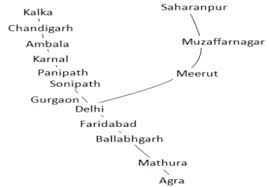
2. (c) Discuss the process of formation of conurbations in India and describe their problems. 15Marks (PYQ/2024)
Answer:
Introduction
Conurbations are vast, continuously built-up urban areas formed by the merging or clustering of adjacent cities and towns. In India, rapid urbanization driven by economic opportunities, rural-to-urban migration, and infrastructural development has resulted in the formation of sprawling metropolitan regions. The evolution of these conurbations can be understood through urban growth theories such as spatial diffusion, the urban transition model, and the central place and core-periphery theories. However, while these agglomerations drive economic growth and innovation, they also pose significant environmental, infrastructural, and governance challenges.


Process of Formation
1. Economic and Demographic Dynamics
- Rural-to-Urban Migration: Changing livelihood opportunities and structural changes in the economy have accelerated rural-to-urban migration. The promise of employment in the industrial and service sectors attracts vast numbers of migrants to urban centers. The cumulative effect of such migration has generated rapid population growth in cities, setting the stage for urban sprawl.
- Industrialization and Service Economy: According to modernization and urban transition theories, the shift from agrarian to industrial and service economies stimulates urban growth. Major cities emerge as economic hubs, triggering the expansion of surrounding towns. Conurbations form as these towns, driven by the diffusion of technology and industry, grow outward and eventually merge with the larger city.
2. Infrastructural Development and Connectivity
- Transportation Networks and Infrastructure Expansion: Investments in road, rail, and mass transit systems have reduced the friction of distance and allowed commuting from peripheral areas into central urban cores. Spatial diffusion models suggest that as connectivity increases, economic activities and residential settlements spread outward, leading to the creation of satellite towns that eventually coalesce with the primary city.
- Policy Interventions and Urban Planning: Government initiatives, such as the development of urban agglomeration projects and regional development plans, also contribute by improving connectivity and facilitating balanced regional growth. However, when urban planning is insufficiently coordinated among multiple local bodies, conurbational growth often becomes unplanned and haphazard.
3. Theoretical Perspectives
- Central Place Theory & Core-Periphery Models: These theories explain how urban centers act as “cores” supplying advanced services to their hinterlands. As smaller settlements increasingly interact with the core, they gradually blend to form a continuous urban fabric.
- Network and Diffusion Models: These models highlight the role of interconnectivity and flow of resources, ideas, and labor, which drive the spatial expansion of urban areas.
Problems Associated with Conurbations
1. Infrastructure and Service Delivery
- Congestion and Overburdened Transport: High population densities often lead to traffic congestion, inadequate public transit, and escalating commute times. Infrastructure often lags behind rapid urban growth, leading to chronic supply problems in water, electricity, and sanitation.
2. Environmental Degradation
- Air and Water Pollution: Industrial emissions, vehicular pollution, and unmanaged waste contribute to poor air quality and water bodies contaminated with industrial effluents. These environmental challenges also exacerbate public health crises.
- Loss of Green Space: Rapid urban expansion frequently results in the reduction of open spaces and urban greenery, affecting urban ecology and quality of life.
3. Socio-Economic Disparities
- Slum Formation and Housing Issues: Housing shortages and unplanned expansions have led to the proliferation of slums and informal settlements, where access to public amenities is limited.
- Governance Challenges: Conurbations often span multiple jurisdictions, creating administrative fragmentation that hampers coordinated planning and the efficient delivery of services.
Case Studies
Case Study 1: Mumbai Metropolitan Region (MMR)

Mumbai has evolved from a colonial port city into a sprawling conurbation comprising satellite towns like Navi Mumbai, Thane, and Mira-Bhayandar. The economic magnetism of Mumbai has driven massive migration, leading to high population density and infrastructural stress. While Mumbai fuels economic growth in India’s financial sector, it also struggles with severe traffic congestion, inadequate public transport, and widespread informal settlements.
Case Study 2: Delhi National Capital Region (NCR)

Delhi NCR is an extensive urban agglomeration that includes Delhi, Gurgaon, Noida, and Faridabad, among others. Economic opportunities in the capital have attracted populations from across the country. However, the region faces challenges such as air pollution, gridlock, water scarcity, and unplanned urban sprawl. Jurisdictional complexities among various administrative units complicate coordinated regional planning, exacerbating the conurbation’s problems.
Conclusion
The formation of conurbations in India is primarily driven by rapid economic transformation, mass migration, improved connectivity, and policy-induced urban expansion. While such agglomerations promote economic dynamism and innovation, they also generate significant infrastructural, environmental, and governance challenges. The case studies of Mumbai Metropolitan Region and Delhi NCR exemplify how unbridled growth, if not properly managed, can lead to severe urban problems requiring sustainable, integrated planning policies.


